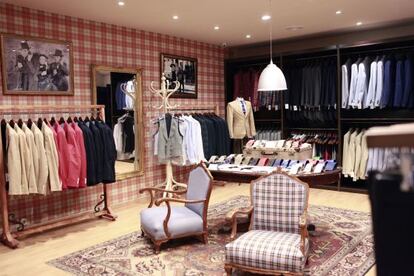Brand new fashion
A younger generation of clothing retailers in Spain has defied the crisis

While the crisis has hit some big-name Spanish fashion retailers, this is not the case of a new generation of brands that started up in the past few years and which continue to expand despite the slump in consumer spending. While retail chains such as Blanco, Caramelo, Basi and Adolfo Domínguez have seen their sales fall, we are starting to get familiar with brands such as Bimba & Lola, Shana, El Ganso, Scalpers, Gocco, BDBA and Kling.
Established in 2006 by two nieces of the designer Adolfo Domínguez, the Vigo-based company Bimba & Lola already has 171 outlets, while Shana, which was founded in Barcelona in 2010 by Julián Imaz, a former director of the giant Spanish fashion retailer Inditex, now has 200 stores. Other brands with a sizeable presence include Madrid-based Gocco, which was set up in 2000, with 200 outlets specializing in clothing for children, and El Ganso, which has a menswear chain comprising 63 stores.
The newcomers have also branched out beyond Spain’s borders. Bimba & Lola has 46 outlets in 17 countries; Gocco has 32 in 12 countries; and El Ganso has 10 sales points overseas. Kling, which focuses on pop fashion for women, has 12 outlets including one in the United States. Scalpers, whose specialty is classical wear for men, with 25 stores in Spain, has increased capital in order to expand abroad, while Shana has just signed an agreement with Alcott to enter the Italian market.
Some of these new chains have increased their sales by tenfold over the past decade. “Since we started up, our sales have never fallen back,” an El Ganso spokesman says. The company is looking to book sales this year of 40 million euros, more than double the 19 million it took in in 2011. Piel de Toro is also aiming to double its revenues this year to 12 million euros, while Scalpers expects an increase in revenues this year of 50 percent to 10 million. Another example of rapid growth is Bimba & Lola, whose sales increased from 17 million euros in 2006 to 71 million in 2011.
Instead of going for low-cost basic clothing, the new brands have opted to make a go of it in the medium-to-high segment of the market. “We have noticed that people are increasingly interested in fashion and are willing to pay for it, and that’s why we have focused on semi-luxury goods,” says a source at Bimba & Lola, where a shirt can cost 95 euros.
It is obvious that these companies offer something that wasn’t there before”
One of the characteristics of the new arrivals on the fashion scene is their ability to make their way in niche areas of the market or find virgin territory. “It is obvious that these companies offer something that wasn’t there before; otherwise it would have been impossible,” says Pablo López, one of the founders of Silbon, which focuses on classical wear for men.
Kling, for example, has positioned itself in the so-called pop fashion segment of the market aimed at “young women who at a particular moment want to emphasize their wild side,” explains Papo Kling, the company’s founder. Others have reinvented the market for men’s suits, with Silbon, Scalpers and El Ganso opting for this segment. As Silbon’s Pablo López explains: “We saw there was a need for a clothes company for the typical client of Britain’s Hackett, but less expensive.”
Seville-based Piel de Toro has centered on upmarket casual wear along the lines of Ralph Lauren, while DBA, which has a store in Madrid’s upmarket Serrano street fashion drag, has focused on clothes for professional women.
The entry of these newcomers has been facilitated by the fact that it is now a lot easier to set up a retail clothing company, with most of the work involved externalized. “It is obvious it has become easier,” says Pablo López. “With just a click you can access thousands of suppliers all over the world and you can advertise yourself on social networks at no cost.”
In addition to the fact that none of these new brands manufacture their own clothes, some of them have latched on to franchising in order to grow. Some 40 percent, for example, of Bimba & Lola’s stores are franchises.
The new brands have also benefited from the problems that wiped out many rivals. “Though it seems bad to say so, this has come as a godsend for us,” Kling says. “It took a lot of our competitors off the scene.”
The disappearance of thousands of retailers has also helped to bring rents down. “Stores that cost 15,000 euros a month to rent can now be had for 6,000 euros,” Kling points out.
Some analysts attribute the ills suffered by leading brands to expansion policies that caused them to build up debts that they were unable to service once the crisis set in.
However, medium-sized fashion retailers can find themselves in niche segments of the market that are ultimately subject to the vagaries of lifestyles and consumption patterns, some of which can disappear. A lack of customer loyalty, the passion for things new, and changing tastes with age can lead consumers to abandon one chain of stores for others. Many companies find it difficult to hold on to customers once they reach adolescence, or go to university or starting working.







































